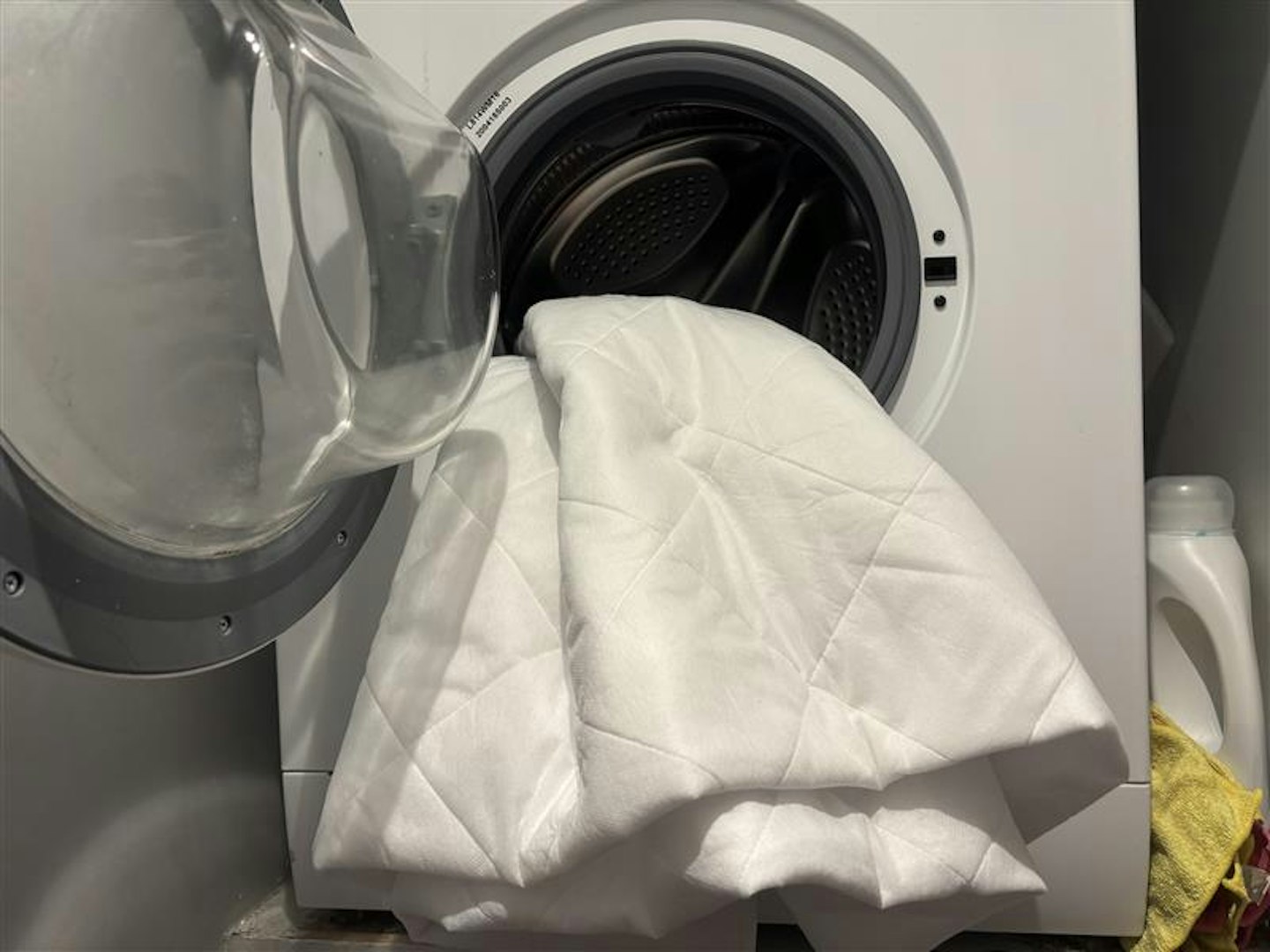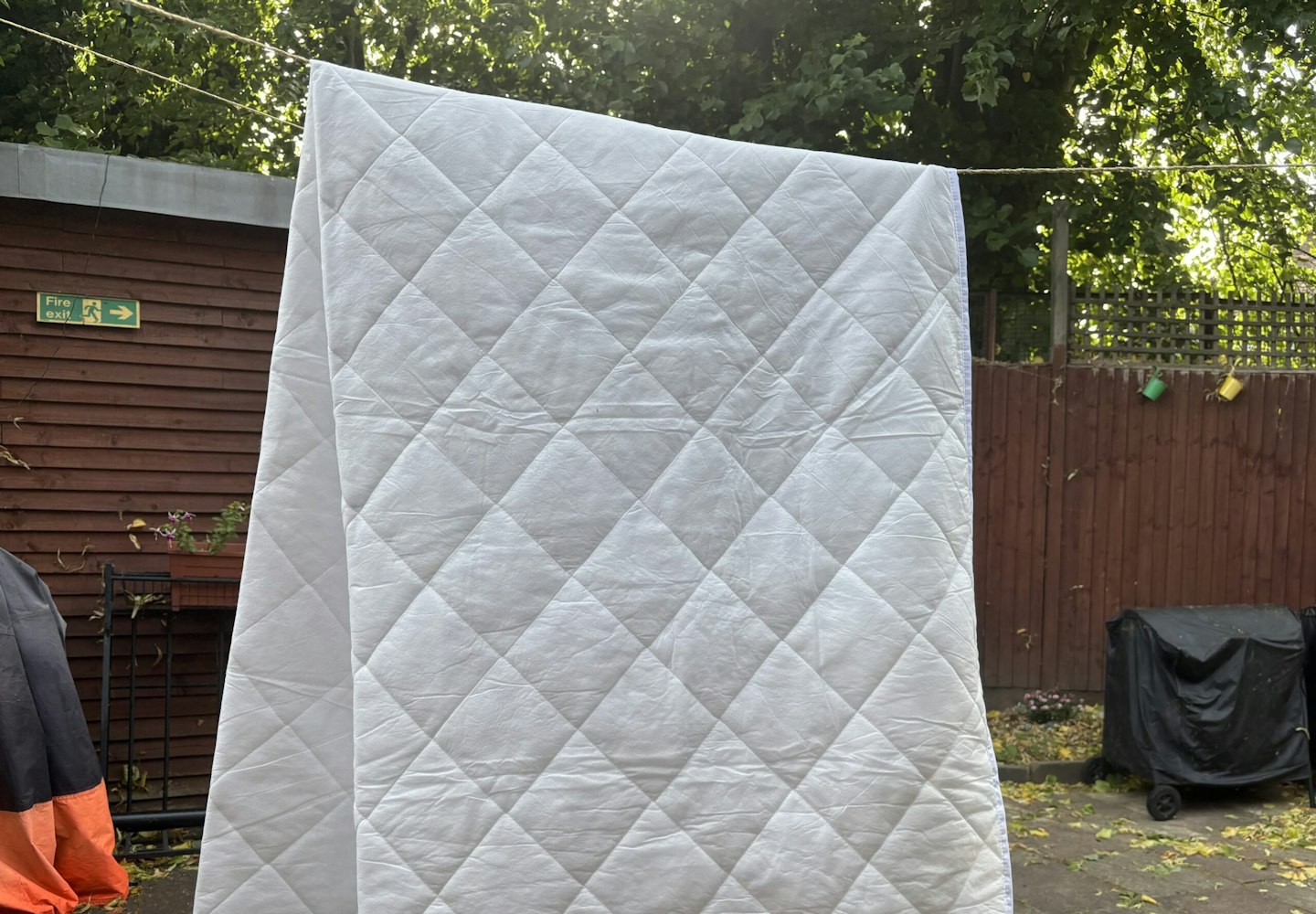There is nothing like the feeling of getting into a warm bed with clean sheets, a trusty feather duvet to keep you warm and maybe even a spritz or two of your favourite pillow sprays. We all know the importance of washing your bed sheets, duvet covers and fluffy throw blankets to keep them fresh and prevent any bad odour or spread of germs. But when was the last time you washed your duvet?
Although your duvets may always be dressed in the most stylish duvet covers or even upgraded to thicker, fleece bedding sets for the winter, with prolonged use, there are chances that accumulated bacteria, dead skin particles and sweat is affecting the hygiene of your bed. So, it is important to make sure that you wash your duvets occasionally to keep them fresh.
Can you wash a duvet?
This is very common question, to bring you some professional guidance on the subject, we spoke to Queen of Clean Lynsey Crombie, author, TV presenter and cleaning guru.
"Yes, you absolutely can but it depends on the type of duvet you have. Always check the care label first, and if your washing machine has the capacity, that’s your best bet for a fresh, clean duvet. Personally, I always choose duvets that are machine-washable at home. It's far more convenient and saves the cost of taking it to a laundrette, which can be pricey," she says.
We also spoke to Jonathan Warren, bed expert and director of Time4Sleep, a brand that specialises in making mattresses, bedding and furniture to improve sleep since 2006. He provided a list some of the things to keep in mind while cleaning your duvet.
“Make sure to wash your duvet in cold or lukewarm water with a mild detergent. This is because strong and fragrant detergents can affect the filling’s ability to breathe. Also, be sure to set your washing machine to a slow or delicate cycle, and don’t forget to add an extra rinse at the end to ensure all the detergent is removed,” he adds.

Can you put a duvet in the washing machine?
Ian Palmer-Smith, an appliance repair expert at Domestic & General, a brand that specialises in repairing all kinds of appliances, from TVs to washing machines, shared his top tips when it comes to washing duvets at home.
"Make sure you aren’t stuffing your washing machine too much. If your machine is overfilled, it could lead to damaging both the duvet and the washing machine which could result in a costly bill," he says.
What products to use to wash a duvet?
"You can use your usual laundry detergent, but I recommend adding a stain remover or a scoop of bicarbonate of soda for extra cleaning power. Bicarbonate of soda helps lift stubborn marks, neutralise odours, and keep white duvets looking bright and fresh," Lynsey says.
Avoid using too much detergent, as duvets can trap residue and always choose a gentle cycle with an extra rinse if available.
How to get stains out of a duvet?
If you spill something on your duvet, you need to do a thorough spot clean to prevent a deeper stain from forming. Make sure to soak up any liquid using paper towels and don’t rub the area as this risks setting in the stain even more. Then try to push as much of the filling away from the area as possible and use a fresh cloth or towel soaked in cold water and dab at the stain area. Make sure you are not using warm water as this will cause the stain to settle in deeper.
If the stain is more stubborn, you can blot the area with a mild detergent, a soap and water mixture, or a baking soda and water paste. Baking soda needs to be left on the stain for an hour or two before cleaning it. Then let it air dry.
Can you tumble dry a duvet?
“It is possible to tumble dry a duvet, but to make sure it’s done properly, use a low heat setting. Using a high heat setting could damage the duvet’s filling whether it’s synthetic, down or natural fibres,” Ian says.
“Make sure to add dryer balls to the cycle. This will help fluff the duvet and ensure it doesn’t clump together. And finally, make sure you set timers to check on the duvet and it is advised to check every 30-60 minutes.”
“If you want the best results, leave your duvet to air out in the open once it’s finished its tumble dryer cycle. That way you get rid of any moisture residue,” he adds.
"Also ensure that your duvet fits comfortably inside your dryer. It's important that the duvet has enough room to tumble freely; otherwise, it won’t dry evenly and could retain moisture, leading to musty smells or even mildew," Lynsey added.

How long does a duvet take to dry?
On a warm, sunny day, you can expect a duvet to dry outside in around 4–5 hours, especially with a light breeze. Sunshine and fresh air are great natural disinfectants too.
"In winter, I wouldn’t recommend relying solely on air drying it can take a full day or longer and risks the duvet staying damp. If you have a tumble dryer and the duvet is safe to machine-dry, that’s the most effective option," Lynsey says.
Alternatively, if you’re drying indoors, hang it over a large airer in a well-ventilated room but be patient, it may take overnight or longer to fully dry through.
How to wash a feather duvet?
“Washing feather duvets is slightly different from the usual down and synthetic duvets because of the way feathers react to heat and water. Feather duvets take longer to dry, so it’s important to factor this into your process when washing them,” Warren says.
“Washing your feather duvet on a lower heat cycle, around 30-40 degrees, and regularly fluffing it when it’s drying will help protect the material for longer,” he suggests.
How often should you wash your duvet?
"Ideally, twice a year. I recommend giving it a good wash at the start of summer and again before winter. If you're changing and washing your bedding weekly, your duvet stays fairly protected from bacteria, dust mites, and general grime," Lynsey says.
However, if you suffer from allergies or have pets who sleep on the bed, you might want to wash it more frequently around every 3–4 months.

What kind of duvets cannot be washed?
Duvets filled with natural materials like feathers or down often can’t be washed at home, especially if they don’t clearly say “machine washable” on the label. These types of duvets usually require professional cleaning to prevent damage to the filling and to ensure they dry thoroughly.
How to wash a duvet without a washing machine?
“If you don’t have a washing machine or if your duvet is too big to fit in the washing machine, it’s still possible to wash your duvet by hand. Every duvet differs, so again, be sure to check the care label before proceeding. However, all you need to wash a duvet is a bathtub and laundry detergent,” Warren says.
-
Fill your bathtub with enough water to fully submerge the duvet
-
Add a small amount of detergent to the water - remember, you’re washing by hand, so the detergent won’t be released from the product as easily, so you don’t need as much as you would with a washing machine
-
Let your duvet soak for 10-15 minutes to allow the moisture to penetrate the materials
-
Gently press and squeeze the duvet and focus on areas with stains
-
You can add softener to keep the duvet extra soft, although this isn’t required
-
Rinse the duvet and gently press it to remove excess water
-
Air dry using a drying rack
When should you throw out a duvet?
You should consider replacing your duvet when it starts to lose its shape, feels lumpy, or looks visibly worn and discoloured. A tired-looking duvet won’t provide the same warmth or comfort, and it may not wash as well over time.
As a general rule, a good-quality duvet should last around 4–5 years. But always trust your eyes and how it feels, if it’s no longer doing its job, it’s time for a fresh one.
Expert tips on how to wash a duvet
Warren’s expert tip when it comes to washing your duvet is to spot clean when necessary.
“Rather than waiting a full 6-12 months before washing your duvet, be sure to do regular checks, and if or when your duvet has a mark on it, instantly wash it. Cleaning it often and little will mean you don’t need to do as many big washes.”
“Alongside keeping your duvet clean, ensure you’re prioritising the cleanliness of your entire bed by regularly dusting, wiping and spot-cleaning. A weekly vacuum and fabric refresh is a must to ensure your bed is kept in top condition,” he adds.
How should you store your duvet?
If you alternate between different duvets or use a lighter duvet during the summer, it is important to store duvets the right way so that they don’t get damaged. Ensure that they are clean and completely dry to prevent odours, mustiness or even mildew. It can be tempting to use a vacuum bag to compactly store your duvet, but it is best to use breathable fabric bags to avoid moisture buildup. It is also best to keep your duvets loosely folded or rolled in a cool, dry place that is away from sunlight.
FAQs
How often should you wash your duvet?
If your duvet hasn’t got any stains or smell, you only need to wash it every 6-12 months. This allows the fabric to stay fresh without damaging any of the internal properties.
Can you dry your duvet on the washing line?
"If the weather is sunny and warm, drying your duvet on a washing line is a great way to dry it off. Just make sure there’s enough airflow - this will mean your duvet dries efficiently. If your duvet appears too large to hang on a washing line, try folding it in half and drying it off in segments. I’d recommend flipping it over every 2 hours to allow air to circulate evenly through the material." says Warren.
“Keep in mind that drying a duvet outside on a washing line can take a long time, so be sure to check the weather and allow a full day to dry."
Akhila Thomas is a digital writer at Yours.co.uk and her areas of interest are beauty, fashion, food, wellness and lifestyle. She has previously written for magazines like Leftlion, Women’s Health and t’Art and worked extensively with art, culture, fashion and social media trends. She also likes to travel and explore new cultures and cuisines.
